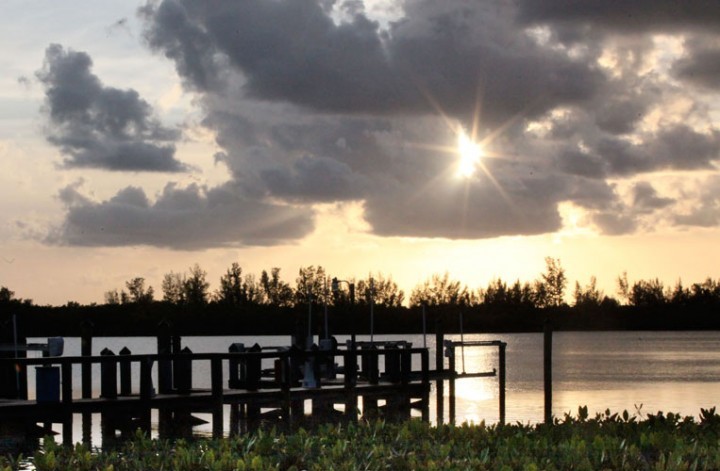
SEBASTIAN — The Sebastian City Council voted 4-1 late Wednesday night to reject the stronger new fertilizer ordinance not only the County Commission passed in August and hoped all its cities would adopt, but also the version members of Sebastian’s own Natural Resources Board supported.
After hours of impassioned discussion at its Sept. 11 meeting, in a chamber full of people on both sides of the fertilizer fence, the council chose to make no change at all, but to retain the state model ordinance now on the books, a powerful step when adopted, but now considered by many to be too vague and too weak.
It was nearly 11 p.m. as the gavel came down, ending the three-plus hours of passionate presentations by environmentalists, scientists and numerous lawn care interests, making their case for and against implementation of stricter regulations regarding where, when and how fertilizer can be applied.
Facing the challenge of an endangered lagoon, environmental organizations argued that nitrogen, delivered into the lagoon by leachate from fertilized turfgrass and fertilizer runoff, is a major contributing factor in the Indian River Lagoon’s current endangered condition.
The proposed Sebastian ordinance would have basically emulated the Indian River County Fertilizer and Landscape Management Ordinance – but with a bit of added strength. Of the six areas of exemption, the city proposal would have excluded golf courses and athletic fields at public parks and schools as long as the FDEP Best Management Practices document was followed, and individual vegetable gardens and fruit trees.
The biggest bone of contention was the county ordinance’s Restricted Season or “blackout period” of July 1 – Sept. 30, during which “no applicator shall apply fertilizers containing nitrogen and/or phosphorous to turf and/or landscape plants.”
This was based on the heightened danger of leaching and run off during the local rainy season, where the volume of rain can move the fertilizer below the root line and into the groundwater. Opponents argued that this period was within the peak turfgrass growing season, when it needed those very nutrients most.
Several representatives of the lawn care industry, mostly from TruGreen Lawn Care, spoke against the ordinance, arguing that blackout supporters were speaking more from emotion than scientific fact. They argued, as well, that jobs would be lost and the industry would be negatively impacted, pointing out that the training fertilizer applicators typically go through assures proper application.
Dr. Laurie Trenholm, a University of Florida professor who conducted a 7-year fertilizer study on Florida’s west coast, provided input that appeared to have significant influence on the board’s decision.
The study, Trenholm explained, found that when fertilizer is applied at the appropriate rates, appropriate timings, and appropriate methods to healthy turf grass, the grass can take up virtually all of the nitrogen.
“The fertilizer bans are not based on the science that we now have,” she stated.
Among those speaking in favor of the strong new ordinance: John Orcutt, marine biologist and environmental activist; Judy Orcutt of Sustainable Indian River Inc.; Chris Costello, representing the Sierra Club; Dr. Richard Baker of the Pelican Island Audubon Society; Gerald Deredita, a member of the Sebastian Natural Resources Board; and other individuals with environmental backgrounds.
Councilwoman Andrea Coy was the lone vote against defeating the stronger ordinance. Coy frequently challenging the arguments of ordinance opponents, often brandishing and quoting from the FDEP “Florida Friendly Best Management Practices for the Protection of Water Resources by the Green Industry” booklet.
“Maybe fertilizer is not No. 1,” Coy said, “but it does make a negative impact. If we take this step tonight, we’re not wiping fertilizer off the map. It’s just common sense. It’s one small step we can take today.”
Councilman Jerome Adams expressed concern that Dr. Trenholm’s study took place on the West Coast and that such a study should be done locally, where results might be different.
Councilman Jim Hill urged, “I ask council to leave it alone – no blackout. No one has shown that there is nitrogen from fertilizer going into our lagoon.”
“We have to base it on science, not emotion,” said Mayor Bob McPartlan.
“It looks like you’ve got a difference of opinion among the scientists,” City Attorney Bob Ginsburg advised. “You’re going to have to make a judgment call.”
Vice Mayor Don Wright, who had initially expressed support of the stronger ordinance as long as it was allowed under state law, noted the vast amount of information on both sides and concluded, “We’re not qualified, but we have to make a decision.”
By the end of the discussion and debate, the Sebastian City Council concluded there was not sufficient scientific evidence that fertilizer was damaging the lagoon, that there seemed to be differing opinions even within the scientific community and that arguments in favor of the new restrictions remained anecdotal.
The vote was taken, at last, well after the traditional 10 p.m. meeting limit, with four supporting leaving the ordinance as is.
At the closing gavel, opponents of the move congratulated one another, and environmentalists expressed disappointment.
“I am very disappointed in the Sebastian Council,” said Baker. “I would have thought they would do everything they can to save the lagoon by having a good, strong ordinance. I am also surprised there were very few Sebastian residents present. Most of the people there were from out of town.”
“Four of the five council members have decided prevention is not the way to go,” Costello said. “Watch out, taxpayers.”



